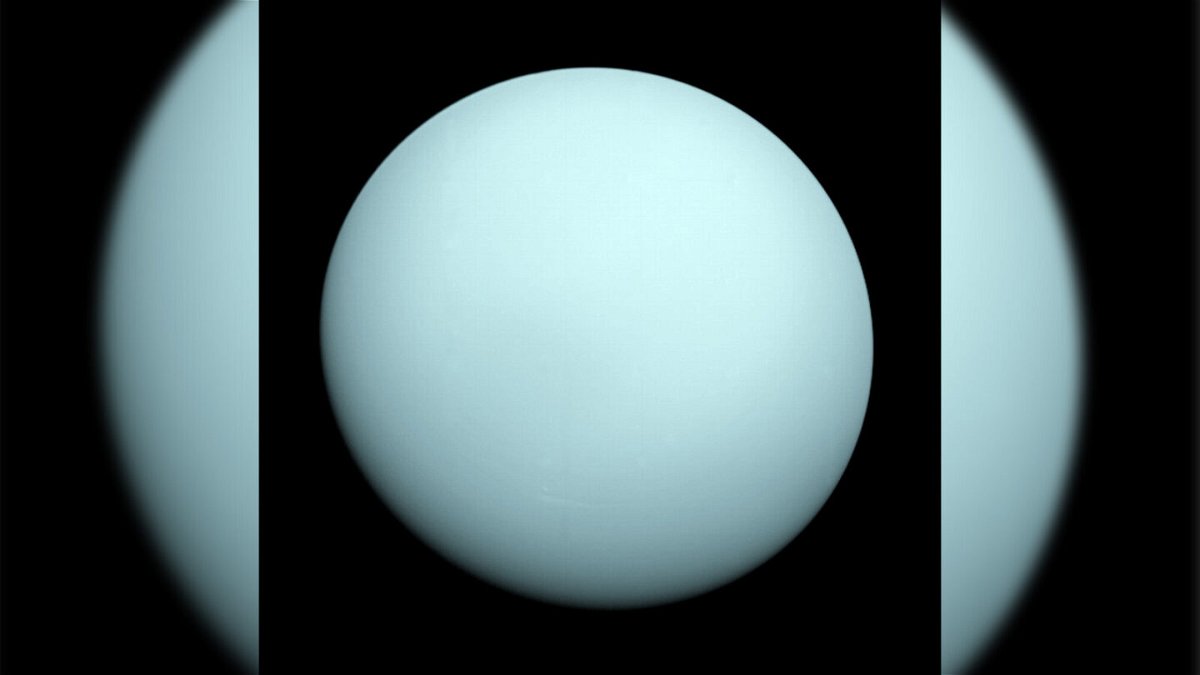Setting an exploratory course for Uranus and an intriguing ocean world

A new report lays out a planetary exploration road map of the future. The planet Uranus image taken by the spacecraft Voyager 2 in January 1986 is seen here.
By Ashley Strickland, CNN
Mysterious, icy worlds in our solar system should be an exploration priority going forward, according to a new report published Tuesday.
The planetary decadal survey recommends the first dedicated Uranus Orbiter and Probe as the next large NASA mission. The spacecraft would conduct an orbital tour of the ice giant during flybys and deliver a probe to explore the atmosphere of the seventh planet from the sun. And a launch in 2031 or 2032 “is viable,” according to the authors of the report.
Looking for evidence of life on Saturn’s moon, Enceladus, should be the second priority for NASA, according to the report. Enceladus contains a liquid ocean beneath an icy crust, and the Enceladus Orbilander would both orbit the moon and land on the surface, studying plumes of water that rise up through cracks in the ice shell.
The survey, produced by the National Academies of Sciences, Engineering, and Medicine, also identifies other scientific priorities for the decade ahead, including planetary defense against near-Earth objects, a new approach to studying Mars, and exploring and sampling other worlds. This report differs from the Astro2020 decadal survey, released in November, which is more focused on unlocking the secrets of the universe and identifying worlds outside of our solar system.
“The report sets out an ambitious but practicable vision for advancing the frontiers of planetary science, astrobiology, and planetary defense in the next decade,” said Robin Canup, assistant vice president of the Planetary Sciences Directorate at the Southwest Research Institute, and co-chair of the National Academies’ steering committee for the decadal survey, in a statement.
Beneath the ice
The authors of the report see the Uranus Orbiter and Probe as a way of revolutionizing the knowledge astronomers have of ice giants in general. Our solar system is home to two — Uranus and Neptune — both made of ice, methane and ammonia with a small rocky core. Only one mission has previously flown by the two planets: NASA’s Voyager 2 in 1989. The rest of what scientists know about these distant planets has been collected using telescopes like Hubble.
But no mission has studied Uranus up close and in detail.
It’s a bit of an oddball, rotating on its side. It has 13 rings, 27 moons and a signature blue-green color from the methane in its atmosphere. The planet doesn’t have a true surface since the majority of its composition is swirling fluid.
Scientists are interested in learning about its atmospheric dynamics, complex magnetic field, and what led to the creation of its extreme tilt and rings. And some of the larger moons orbiting the planet could potentially be ocean worlds.
The Uranus Orbiter and Probe could gain more insights about the planet’s origin, interior, atmosphere, moons and rings.
Meanwhile, planetary scientists have hoped for years to fly a spacecraft through the active plumes of gas and particles that erupt from Enceladus’ interior ocean. The Enceladus Orbilander could directly study if the moon’s ocean is habitable.
The Enceladus mission would search for evidence of life and determine if it could exist on the ocean world. If the mission were to launch later this decade, it would likely arrive at the distant moon in the early 2050s. There is also a suggestion for a separate mission that could conduct multiple flybys of Enceladus if the Orbilander isn’t feasible.
Other destinations
The report also recommends that NASA send missions to return samples from the dwarf planet Ceres as well as the surface of a comet. The Ceres mission could assess if the dwarf planet, which can be found in the main asteroid belt between Mars and Jupiter, is habitable.
Other missions on the list include a Venus explorer, a probe to fly through the atmosphere of Saturn and an orbiter around Saturn’s moon Titan. Titan is of interest to researchers because its dense atmosphere is home to prebiotic molecules, which is a feature similar to how Earth’s atmosphere started out before life appeared. The Titan mission would investigate if the moon could harbor life.
The report suggests sending an orbiter and lander to one of the Centaurs, or primitive small icy bodies found between Jupiter and Neptune.
When it comes to Mars, the authors recommend continuing with the current rover program and multistep mission to return samples from Mars to Earth. But they also encourage creating the Mars Life Explorer, a mission that would look for existing life and determine if it’s possible that life exists on Mars today.
There is also a desire to make sure that scientific endeavor is maximized as humans return to the moon through NASA’s Artemis program, collecting lunar samples and setting up instruments on the surface that can reveal more about its history.
Understanding more about near-Earth objects, like tracking and detecting space rocks that could pose a threat to Earth, is a clear priority. The authors recommend that NASA develop and launch the NEO Surveyor, an infrared mission that could provide a better foundation for modeling and predicting the movements of near-Earth objects. In turn, this information would help in the design of deflection missions.
Once NASA’s existing DART mission, or the Double Asteroid Redirection Test, and NEO Surveyor provide data, the next steps would be a rapid-response reconnaissance mission to target a near-Earth object between 164 to 328 feet (50 to 100 meters) in diameter. These objects have the highest probability of causing mass destruction should they collide with Earth.
“This recommended portfolio of missions, high-priority research activities, and technology development will produce transformative advances in human knowledge and understanding about the origin and evolution of the solar system, and of life and the habitability of other bodies beyond Earth,” Canup said.
The-CNN-Wire
™ & © 2022 Cable News Network, Inc., a WarnerMedia Company. All rights reserved.



